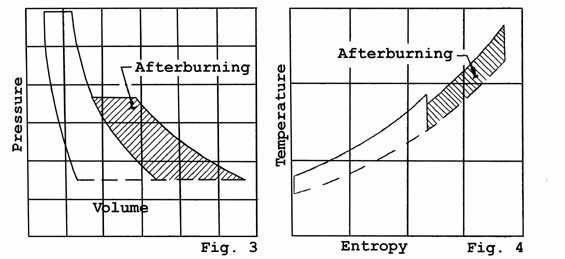|
The pressure volume diagram for a jet engine with and without afterburner is shown on Figure 3, and the corresponding temperature entropy diagram on Figure 4. The shaded area represents the addition of the afterburner. Since, as previously mentioned, basic engine performance is not affected by afterburning, the airflow through the engine does not change, and the useful work of the afterburner cycle shows up as increased velocity of the exhaust gases and thus an increase of thrust,
|
|

|
|
Although the estimation of actual afterburner performance is a rather involved process, a very close approximation can be obtained by simple calculations which neglect certain secondary corrections. These calculations are useful in obtaining a clear understanding of the afterburning process.
For a typical jet engine without afterburning, the exhaust gas total temperature is in the vicinity of 17000R and the velocity is approximately sonic or l820 ft./see. If the exhaust gas temperature is raised by afterburning and the pressure ratio across the nozzle is unchanged, the exhaust gas velocity will vary as the square root of the absolute temperature, and the thrust will also vary as the square root of the absolute temperature. Thus, if the exhaust gas temperature is raised from 17000R to 30000R by afterburning the jet velocity will be
|
|

|
|
and the increase in engine thrust will be 2420/1820 or 33 per cent. The only limitations on the thrust which can be obtained are the allowable temperatures of the afterburner structure, and the amount of excess oxygen available for combustion In the afterburner.
It will be noted in the example above that increasing the exhaust gas temperature from 1700 to 30000R by afterburning increased the velocity by 33 perr cent. However, the specific
|
|